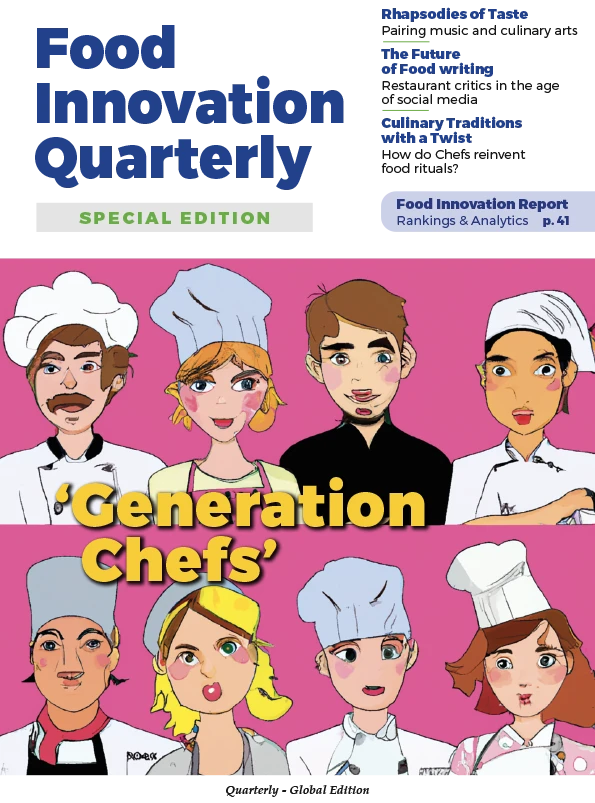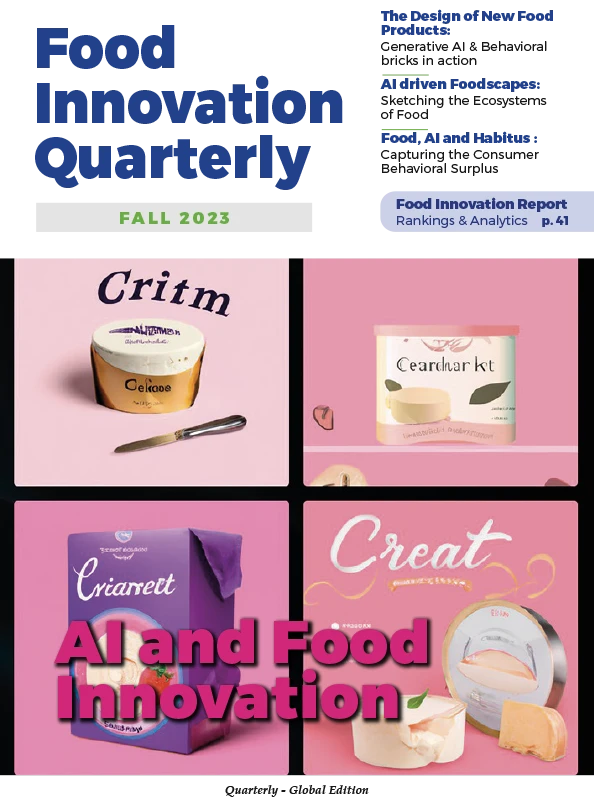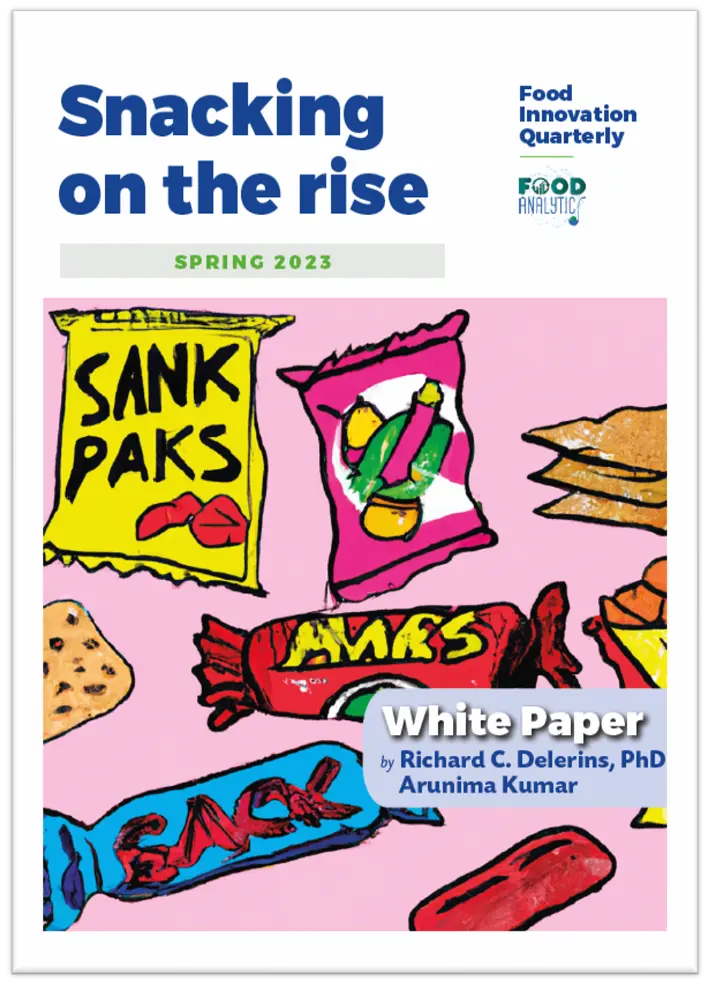Food Innovation Quarterly: Amy, could you briefly share with me what led to your role there?
Amy Sherman: Sure. I’m a food writer, recipe developer, I have written about cheese for a variety of publications, and had actually done some copywriting for the French Dairy Board. Also, I grew up in the San Francisco Bay area, which is kind of an epicenter for the craft cheese movement. I didn’t realize that until later in life when I realized not everybody had all these cheese producers in their backyard! So I’m very familiar with cheese.
The publisher of The Alcohol Professor decided to launch a sister site, The Cheese Professor. We had a couple of conversations, I wrote a few stories, and he said “I’d like you to take on the role of editor.” So that was very good timing – it was a pandemic job, and a lot of my freelance clients were in complete and utter disarray due to lockdown mode. Moving from freelancing to editorial was a very good move for me.
I have a lot of really good contacts in the cheese world, people I knew before I took the job. So while I wouldn’t consider myself an expert in cheese, I know more than most people! I learn a lot from the stories that we publish on our site, and I’ve been several times to the American Cheese Society’s annual conference.
F.I.Q: It’s the breadth of the stories that you publish on your site that led me to ask for this interview, because while you may not consider yourself an expert, you certainly have very broad exposure to the world of cheese. So I really appreciate your time today.
A.S: You know, it’s been four years, and we have not run out of topics. There is just so much to write about, and I’m always looking for stories that go a little bit beyond. Stories for the enthusiast, for someone who’s already interested in cheese. We do some fun pop culture kinds of pieces, but we do a lot of really deeper dives and, and I require that my writers quote experts whenever possible. We really try to bring a level of quality to what we do.

F.I.Q: I have four specific questions. They’re big questions, but they’re very specific. So that will constitute the interview today. The first one is, as we were talking about, the website showcases so many interesting cheesemakers. Especially here in the U.S., ones that are expanding the definition of what American cheese is all about. Are there a few shining stars that you would want to showcase? And more importantly, do you see any commonalities across the people behind this American cheesemaking renaissance, anything that is motivating them and driving them to do what they do?
A.S: Good question. It’s hard to generalize, because on the craft and artisanal side, there are people who have been around since the beginning of that movement, like Judy Shad at Capriole Goat Cheese (in Indiana). Unlike Laura Chanel and many other pioneer artisanal producers, she’s still producing cheese. Granted, her family is working with her. But it’s becoming a multigenerational business, which is really interesting.
There are a number of interesting cheesemakers who came from dairy families – not necessarily cheesemaking families, or if they were making cheese, they were making—I hesitate to call it industrial cheese—but very standard cheese that wasn’t craft or artisanal or unique. And now we see this next generation which, for various reasons, has moved towards artisanal and craft cheesemaking.
One reason that they move towards that is, frankly, money. You make very little money producing milk, you make a little bit more producing cheese as an added value product, but you make a lot more when you start to get into artisanal and craft cheese. You’re talking about pennies per pound of milk versus, maybe, $5 a pound when you’re selling standard kinds of cheeses. And then when you get into the artisanal and craft cheeses, you could be looking at $30 to $50 per pound of cheese, or more. Now, granted, the risks are much greater.
I also think that there’s an interesting thing going on with very young people who are looking for a new way to get back to the land, to be involved with agriculture, and who see that cheese is this can be this really beautiful experience where they’re working with animals, they’re working with the environment, they’re crafting something that’s really creative and beautiful.
I think the creativity that you’re able to express yourself with is truly what sets American cheese apart from cheeses from other countries with longer traditions and a heritage that’s greater than ours. But the creativity that’s happening here is really quite amazing. And it’s influencing cheesemakers around the world.
I remember one of the first interviews I did with a cheesemonger expert and I asked him, “Once the pandemic’s over, where do you wanna go for cheese?” And he shocked me by saying Japan. I was not expecting that! And he’s Italian and has a very well-known Italian cheese shop in Philadelphia. So the creativity that’s happening in places like Japan is really fascinating to me, and it’s very much influenced by what they see in the United States, but using local ingredients.
I’m kind of focused on local ingredients at the moment because there is so much diversity in what’s being used to flavor and coat or wrap cheeses. That’s long been done in France with ash and grape leaves. But I think American producers have gone much, much further in this area.

F.I.Q: That’s a perfect segue to my next question. Some of the cheeses that are featured on The Cheese Professor are noteworthy because they hearken back so faithfully to their European origins, their traditional way of being made, their traditional sensory profile and so on—while other ones you feature are truly departures from their starting reference points. What are some of the most interesting variations on tradition that you’ve observed from American cheesemakers?
A.S: Well, you know, it’s interesting. There was a time when people turned up their nose at flavored cheeses. Like, the cheese by itself should be good enough; you don’t need to flavor it. You don’t need to add anything to make it better. But to be honest, Americans love flavored cheeses. They have always loved flavored cheeses. And they can be quite delicious!
And you have a cheese like Humboldt Fog. It has the wow factor—it’s so impressive. Yeah, it’s similar to some cheeses in France, but it’s completely an American original, which makes it really cool.
Some of the particularly interesting things I’ve seen are cheeses using seaweed and seawater, trying to forge this connection between the land and the sea. And with really interesting results, a briny flavor. Even in my own backyard, Marin French Cheese Co., the oldest continuously running cheese company in America, they’re using a lot of ingredients that really speak to West Marin where they’re located. Rosemary, pears, red wine and all different kinds of ingredients.
Of course, most interesting ingredients perhaps really are the natural molds and yeasts that are in the air. That’s what created a lot of the most famous French cheeses, because there was a specific mold or yeast in the air that happened to create a certain style of a cheese, that then they had to figure out how to replicate. This happened by accident at Cowgirl Creamery (in California), when their facility became “infected” with wild B. linens (a beneficial bacterium often found on cheese rinds). It created this beautiful cheese that they couldn’t even replicate in another location because it was just in the air, it was truly local. It’s interesting how our cheese making mirrors what has happened in older cheese making cultures, right?
Then I think of Sartori (in Wisconsin) that has their BellaVitano line of cheeses. They make some really beautiful cheeses, all flavored, and it might sound kind of crazy to use raspberry or espresso or whatever. Beehive (in Utah) is the same thing. They only make one cheese, and all their varieties are flavored versions of that one cheese, but they’ve won a ton of awards. They’re really spectacular and they tell wonderful stories of why they’re combining the lavender with the ground coffee, for example, and the results speak for themselves. I would guess that American consumers in general are simply more open to that.
F.I.Q: Cheese plays so many different roles in the American food repertoire. I would say probably more than in most countries. We eat its as an appetizer. We put it on sandwiches, we put it on pasta, we melt it into pasta sauce, we use it as a flavoring for Cheetos and other savory snacks and so on. So cheese shows up in all these different places. Also, some of that’s about individual consumption, while other times it’s about gatherings and socializing, like the cheese board phenomenon, for example, that’s so connected with socializing. Where would you see the most likely new avenues for cheese to emerge, especially among younger consumers in when they eat it and how they eat it?
A.S: Yeah, I think snacking is huge, so anytime you have an opportunity for people to enjoy cheese as a snack, that has potential. Think about the phenomenon of string cheese. I mean, when I was growing up, there was no such thing, then suddenly string cheese was everywhere and kids loved it. When I was little, it was The Laughing Cow. Processed cheese for kids. From an early age, American kids learn about cheese and I don’t think that ever goes the way. And those cheese boards are sometimes a meal, but they’re often a snack.
We’ve seen a lot of innovation around smaller boards, individual cheese boards, and some of that was pandemic-related about not wanting to share food, but it started something new. Those dried cheese crisps, those little wisps, that’s another innovation, very creative. They’re based on the traditional Italian frico, a little Parmesan cheese cooked on a griddle till it crisps up and makes a little cracker. But here, they’re sold in bags. You can’t go to a Costco without seeing a million of those. So that’s a whole category of food.
With cheese finding its way into snacks, we’ll see different form factors coming up. I’ve already seen some producers experimenting with different shapes and sizes. A lot of artisanal producers are experimenting with smaller formats because, you know, a $7.99 impulse buy is much easier than an $18.99 one, right?
F.I.Q: My last question is really comparing European consumers to American consumers. I would say the American market is really a bit of a balancing act. You have enjoyment, you have indulgence, you have nutrition, you have overall health concerns. Consumers are navigating their way through that, but cheesemakers have to be cognizant of it. Which way do you think the compass needle is pointing in the future?
A.S: My own personal feeling is that cheese is still an affordable indulgence. It’s less expensive than a lot of other very indulgent things that we eat. And I talk to cheesemongers all the time who say small precuts, the little ends they have when they’re breaking down a large wheel, they’ll package them up and they just fly off the shelf. That signals this idea of people who are looking to indulge in a more moderate way. As Americans, we do tend to swing one way or another. You know, we’re eating cheese because it’s healthy and then we’re not eating cheese because it’s not healthy, instead of just saying “moderation in all things”. Probably no one ever died from cheese, but probably no one ever lived to 100 because of cheese. So let’s try to find some balance.
One of our best performing stories is about what cheeses I can eat if I’m lactose free, what if I’m on a keto diet? So, there are a lot of people still searching for that kind of content and very consumed with it. But then I see what people are buying in the store. And I just think we’re moving towards moderation in our indulgences. And this doesn’t just apply to cheese, but to all dairy products, so we’re seeing a proliferation of yogurt-like products like kefir and quark that have moved from fringe products to more center of the aisle.
Butter, I’m fascinated by butter. We used to have maybe two brands in the supermarket, that was it. You either bought butter or you didn’t. Now, there’s this proliferation of American-made European-style butters, as well as butters imported from Europe — France, Ireland. We’re allowing ourselves to indulge and enjoy a little bit more and maybe that’s buying a half a pound of a European or a European-style butter that costs twice as much, but it’s still under $10. It’s an affordable indulgence, not a jar of caviar!
F.I.Q: Those are the questions I have any, any closing thoughts that you’d like to share?
A.S: The craft and artisanal movement in the United States is reflected in cheese the same way you see in wine and other categories. So I think we’re a little bit later to the party. But the creativity that we have is phenomenal. And I also think it’s interesting to see regionally what’s happening with cheese. We focus a lot on California and Wisconsin. But what’s happening in Minnesota, for example, is just incredible. In the South, we’re starting to see really incredible cheesemakers in Tennessee. We’re still in the early days of the craft movement and we’ll see more creativity and more producers, maybe they’re really small scale or maybe they only sell very limited distribution. But I think the appetite for interesting cheese is there.
Interview by Tom Grimm for Food Innovation Quarterly






